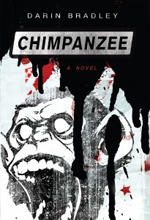
 Chimpanzee
Chimpanzee
Written and narrated by Darin Bradley
Publisher: Resurrection House via Audible
Publication Date: 9 October 2014
[UNABRIDGED] – 5 hours, 46 minutes
Themes: / dystopia / unrest / cognitive theory / virtual reality / revolution /
Publisher summary:
Unemployment has ravaged the U.S. economy. Foreclosures are rampant. People struggle everywhere, exhausted by the collapse that destroyed their lives . . .
Benjamin Cade is an expert in cognition and abstract literature, and before the flatlined economy caught up to him, he earned his living as a university instructor. Now, without income, he joins the millions defaulting on their loans—in his case, the money he borrowed to finance his degrees. But there are consequences.
Using advances in cognitive science and chemical therapy, Ben’s debtors can reclaim their property—his education. The government calls the process “Repossession Therapy,” and it is administered by the Homeland Renewal Project, the desperate program designed to salvage what remains of the ravaged U.S. economy. The data Ben’s repossession will yield is invaluable to those improving the “indexing” technology—a remarkable medical advance that has enabled the effective cure of all mental disorders. By disassembling his mind, doctors will gain the expertise to assist untold millions.
But Ben has no intention of losing his mind without a fight, so he begins teaching in the central park, distributing his knowledge before it’s gone in a race against ignorance. And somewhere in Ben’s confusing takedown, Chimpanzee arrives. Its iconography appears spray-painted and wheat-pasted around town. Young people in rubber chimpanzee masks start massive protests. A new use of the indexing technology shows up in bars across the country. It’s called “chimping” . . . named after the mysterious protest movement, and it uses goggles and electrodes to reverse the curative indexing process, temporarily (recreationally) offering those inclined a mental illness of their own choosing.
As Ben slowly loses himself, the Chimpanzee movement seems to grow. And all fingers point to Ben . . . or maybe the voice that speaks to him every time he uses the chimping rig. As civil unrest grows, and Homeland Security takes an interest, Ben finds himself at the center of a storm that may not even be real. What is Chimpanzee? Who created it? What does it want?
And is there even enough of Ben left to find out?
What I prefer in my dystopia is realism and possibility, that it could happen here, in my lifetime. I read dystopia for the horror, for the thrill. That is the brilliance Darin Bradley brings to his novels, both in Noise and in Chimpanzee. It helps that Chimpanzee takes place in a town an hour from where I live, a place I visit often, particularly the arts district, where quite a bit of the action takes place. The events are very vivid to me, described in that place. They will be vivid to others for different reasons, but basically anyone watching the news in the last few years will feel they know the world of this novel.
The premise of Chimpanzee (see description above) may be even more chilling to those of us working in academia, who have seen the impact of the various economic downturns on expensive liberal arts educations. Now that there are no job guarantees, and no guarantee on the investment made (often by the students through hefty loans), people are starting to question the benefit of the system we have maintained for so long. I hate this conversation, because I work at one of those schools, and depend on it for my livelihood. So did the author, for a while. And that’s where reality and the terror of this possible future start to blur within the novel.
There is a lot in this novel that might feel over the reader’s head. I would encourage people who don’t understand every word from the rhetoric of cognitive theory to press on – treat it like a classic science fiction info dump. Let it wash over you, grasp what you can. You will be in the same place as the students in the story, who also are put into a position of creating their own meaning, applied to their real situations.
There is a concept of virtual reality in this novel that I liked, called chimping, something you can do at a bar with your friends. It becomes an important part of the story in ways I will not give away here.
The audiobook has a story to its making. In the insert, it talks about the initial difficulty Resurrection House had in distributing the audio version. It includes a warning:
“Because some books aren’t meant for sedans on highways. They may have too many voices, or they may have jagged corners that snag plots, or they may have things with no business being in stories… like symbols or formulae or languages we don’t understand. You can listen to them, if you’re ready to pay attention.”
I did not heed the warning and listened to some of this audio production while driving around. The first time I encountered a repossessed memory, the sound used to represent the hole, the deletion, it almost sent me off the road. When I played it at home, my husband jumped out of his skin. It would be remiss not to warn you.
Otherwise, the audio moves back and forth between a radio-play style performance from multiple readers with sound effects and music, and the author’s own narration. I liked the music choices and the sound effects were generally effective. Having sound effects in some parts magnifies the silence of the others. Benjamin Cade spends a lot of time inside his head, and losing what is in his head, so I think that silence is well warranted. It takes some getting used to, but I ended up appreciating it. The author also does a good job delivering his narration in a noirish tone, where short sentences shine.
Posted by Jenny Colvin
 Fool’s Fate (Tawny Man Trilogy #3)
Fool’s Fate (Tawny Man Trilogy #3) Tales of Terror Collection
Tales of Terror Collection Heraclix and Pomp: A Novel of the Fabricated and the Fey
Heraclix and Pomp: A Novel of the Fabricated and the Fey Martian Time-Slip
Martian Time-Slip